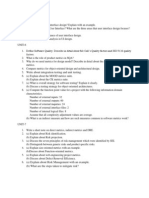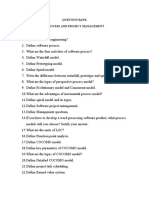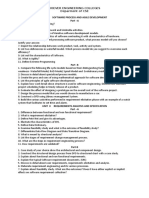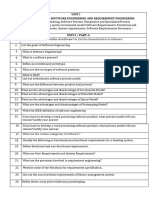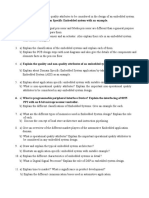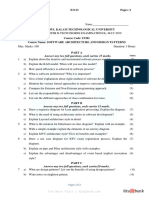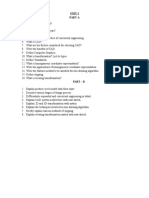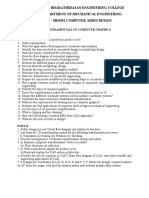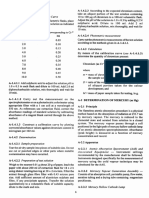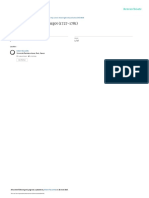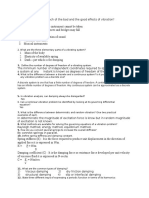SDE Question Bank
SDE Question Bank
Uploaded by
M HARSHITHA 20R01A05M7Copyright:
Available Formats
SDE Question Bank
SDE Question Bank
Uploaded by
M HARSHITHA 20R01A05M7Copyright
Available Formats
Share this document
Did you find this document useful?
Is this content inappropriate?
Copyright:
Available Formats
SDE Question Bank
SDE Question Bank
Uploaded by
M HARSHITHA 20R01A05M7Copyright:
Available Formats
Unit-1:
Part-A
1. Explain about software engineering layered technology
2. Define Software Engineering?
3. Name the specialized process models.
4. Who are the users involved in writing the SRS.
5. List the stages of processing models.
6. Outline the diagram of requirement change management
7. List the software requirements.
8. Draw the diagram of different non-functional requirements.
9. Outline the feasibility study.
10. Define scenario?
Part-B
1. a) Compare the Waterfall & Incremental models with a neat diagram.
b) Explain the requirement engineering process with a neat diagram and explain in detail about
Requirement Validation.
2. a) Analyze the CMMI levels in detail.
b) Compare Functional and Non-Functional Requirements.
3. a) Analyze “Spiral process Model” with neat diagram along with advantages and disadvantages.
b) Explain in detail about the “System Requirements Specifications” (SRS Document).
4. a) Discuss prototype process model with a neat sketch.
b) Draw the diagram of Requirement Engineering Process & Explain in detail about Requirement
Elicitation and Requirement Analysis.
5. a) Describe the concurrent Model with neat diagram.
b) Discuss in detail about Requirement Validation.
6. a) Analyze the Process Assessment with diagram.
b) Discuss User requirements
7. a) Illustrate RAD with a neat diagram
b) Discuss the various problems arise when user requirements are written and guidelines to minimize the
problem.
8. a) Interpret the evolving role of software.
b) Describe System requirements.
9. a) Interpret the work products of inception and elaboration of phases of unified process and draw the
diagram of Unified Process.
b) In detail explain the requirements management.
10. a) Discuss the construction and transition phases of unified process.
b) Illustrate different view points with examples.
Unit-2:
Part-A
1. Name elements of design model?
2. Why software architecture is so important?
3. List the quality attributes.
4. Give the importance of architecture
5. Explain functional dependency of design concepts.
6. Define component.
7. Give the difference between architectures and patterns.
8. Name the “Golden Rules” of designing.
9. Give the characteristics of a “Well-Formed” design class.
10. List the component level design guidelines.
Part-B
11. a) Summarize types of cohesions.
b) Illustrate different types of “Architectural Styles” with neat diagrams.
12. a) Outline the architecture of representing the system in context.
b) Define design process. Explain the design characteristics.
13. a) Explain the following Design Concepts:
(I) Abstraction, (II)Modularity, (III)Design classes
b) Discuss about process in “User Interface Analysis & Design”.
14. a) Illustrate about the Architectural Design.
b) Discuss interface, dependency and inheritance of component level design guide lines.
15. a) Interpret representing the system in context and defining archetypes of architecture design.
b) Explain the following couplings with suitable examples.
(I) content coupling (II) Common coupling (III) Control coupling (IV) Stamp coupling
16. a) Illustrate the quality design concepts.
b) Describe principles of the “Golden Rules”.
17. a) Discuss the design model with neat graph.
b) Explain in detail about model in “User Interface Analysis & Design”.
18. a) Describe the data design.
b) Summarize the design concepts
(I) Architecture, (II) Pattern, (III) Information hiding, (IV) Refactoring
19. a) Interpret the architectural patterns.
b) Compare cohesion and coupling.
20. a) Discuss the refining the architecture into components and describing instantiation of the system of
architectural design.
b) Explain the following couplings with suitable examples.
(I) Data coupling (II) Routine call coupling (III) Type coupling (IV) Inclusion or Import coupling (V)
External coupling.
Unit-3:
Part-A
1. Give the importance of UML.
2. List the basic elements of UML.
3. Name the building blocks of UML.
4. What is thing?
5. Define class and object.
6. List the different types of actors.
7. Differentiate action and activity states.
8. Explain control of focus with examples.
9. What is node? Give the notation of node.
Part-B
10. a) Explain the principles of UML
b) Model the activity diagram with suitable examples and explain its contents.
11. a) Discuss the structural things of UML.
b) Describe state chart diagram with suitable examples
12. a) Summarize the graphical notations for the following:
(I) Behavioral things (II) Annotation things
b) Model the use-case diagram for cellular telephone and its common modeling techniques.
13. a) Discuss relationships with its graphical notations.
b) Develop a sequence diagram for cellular network and explain its contents.
14. a) Explain diagrams in UML.
b) Develop and define collaboration diagrams with suitable examples
15. a) Describe the rules of the UML.
b) Discuss component diagram with its common modeling techniques.
16. a) Explain the common mechanisms in UML.
b) Model a deployment diagram with its common modelling techniques.
17. a) Develop the class diagram for company management system. Define aggregation relationships.
b) Compare sequence and collaboration diagrams.
18. a) Discuss the common modeling techniques of class diagram.
b) Explain the different transitions of activity diagram with its notations.
19. a) Explain object diagram with suitable examples.
b) Compare static and dynamic diagrams.
Unit –IV
Short Questions:
1. Write a short note on black box testing?
2. Distinguish between verification and validation?
3. Draw the diagram of debugging process?
4. Write about drivers and stubs?
5. Explain about alpha and beta testing?
6. List the metrics for Design model?
7. Elaborate the formula used for integrity of a system in measuring quality?
8. List out the six key quality attributes of ISO 9126 Quality Factors?
9. Explain the need of Function-Oriented metrics?
10. Write short notes on direct measures and indirect measures?
Essay questions:
1. a) Explain the Metrics for Source Code and Metrics for Maintenance?
b) What is Software Testing? Explain clearly the System Testing?
2. a) Differentiate between Top-down integration and Bottom-up integration?
b) Explain in detail the Metrics used for Testing?
3. a) Discuss in detail the Art of Debugging with neat diagram?
b) Explain in detail the concept of Unit testing with examples?
4. a) Explain clearly about techniques used for Integration testing with examples?
b) Why we need Validation testing? Explain types of approaches used for validation testing?
5. a) Explain the following terms with examples
i)Graph-based testing methods ii) Boundary Value Analysis
b) Write a short note on Regression testing and Smoke testing?
6. a) Discuss about Cyclomatic complexity of white box testing with examples?
b) Explain the following terms with examples
i) Method Inheritance Factor ii) Coupling Factor
7. a) State the concept of Component Level Design Metrics with examples?
b) Explain in detail about a strategic approach to Software Testing?
8. a) What is Software Quality? Explain the factors used for Software Quality?
b) Give a detail note on Architectural Design Metrics?
9. a) Explain about Metrics used for the Analysis Model with an example?
b) Illustrate the concept of Defect Removal Efficiency?
10. a) Explain the following terms with examples
i) Object-Oriented Metrics ii) Web Engineering Project Metrics?
b) Explain about the Metrics used for Software Quality?
Unit-V
Short questions:
1. Differentiate between reactive risk and proactive risk strategies.
2. What is software reliability and how this parameter helps in managing software quality?
3. Define Quality management. What are the types of Quality management?
4. What is the importance of software reviews?
5. Write a short note on Risk Projection?
6. List out three core steps of six sigma methodology?
7. Predict why we require Formal Technical Reviews?
8. State the two characteristics of software risks?
9. Discuss about internal failure costs and external failure costs?
10. Draw the diagram of Risk management concern?
Essay questions:
1. a) Explain in detail the techniques used for Risk Projection?
b) Illustrate the concept of RMMM Plan?
2. a) Discuss about Risk components and Drivers?
b) Define Software risk? Explain different categories of software risks?
3. a) Summarize the concept of Risk Refinement with example?
b) Describe the checklist used for Risk Identification?
4. a) Explain the following terms with examples a) Quality b) Quality Assurance?
b) Explain the activities of software quality assurance group to assist the software team in achieving high
quality?
5. a) Discuss in detail about Cost impact of software defects and Defect amplification & removal
with examples?
b) Explain in detail about Review meeting and Review Guidelines with examples?
6. a) Write a detailed note on ISO 9000 quality standards?
b) Summarize the concept of Software Reliability?
7. a) Explain the following terms with examples
i) Review Reporting and Review recording ii) Sample Driven Reviews
b) Define Software Quality? How the cost of Quality is measured?
8. a) Why the Six Sigma strategy is needed in statistical quality assurance? Explain it.
b) What types of risks occur during software development? Discuss?
9. a) What is the significance of Formal Technical Reviews? Explain
b) Give an example how a software team defines a project risk?
10. a) Summarize the concept of Risk Mitigation, Monitoring and Management?
b) Illustrate the concept of Software Quality Assurance?
You might also like
- I-Products and Scope Efficiency: Organization & Strategy Final Paper - May 31 2013Document26 pagesI-Products and Scope Efficiency: Organization & Strategy Final Paper - May 31 2013shefali srivastavaNo ratings yet
- SQM 16 & 2marks With AnsDocument21 pagesSQM 16 & 2marks With AnsKalyan SundaramNo ratings yet
- Unit Wise BankDocument35 pagesUnit Wise BankThirupathi Reddy LingalaNo ratings yet
- QuestionsDocument2 pagesQuestionsChandra Shekar Reddy TummuriNo ratings yet
- OOSE Question BankDocument8 pagesOOSE Question Bankabhinandu0728No ratings yet
- SWENGGG QBankDocument6 pagesSWENGGG QBankKarthick ThiyaguNo ratings yet
- IT6602 SA Coaching Class QuestionsDocument3 pagesIT6602 SA Coaching Class QuestionsvinothNo ratings yet
- Write About Integration Testing and Unit TestingDocument2 pagesWrite About Integration Testing and Unit TestingdeeuGirlNo ratings yet
- PDDDocument5 pagesPDDSimbhu Ashok CNo ratings yet
- QuesDocument3 pagesQuesMD ARIFNo ratings yet
- SE - 2011 - 2nd EditionDocument9 pagesSE - 2011 - 2nd EditionRam GopalNo ratings yet
- Question Bank For Software Architecture Regulation 2013Document10 pagesQuestion Bank For Software Architecture Regulation 2013PRIYA RAJI100% (2)
- OoadqbankDocument38 pagesOoadqbankkumaresanNo ratings yet
- Se QBDocument6 pagesSe QBpriyajv14No ratings yet
- EndSemModelQuestions SEnggDocument1 pageEndSemModelQuestions SEnggrishabhmcu001No ratings yet
- Software Engineering QBDocument6 pagesSoftware Engineering QBKarthick ThiyaguNo ratings yet
- Software Engineering QUESTION BANKDocument11 pagesSoftware Engineering QUESTION BANKHema MaheNo ratings yet
- SE Important QuestionsDocument2 pagesSE Important Questionsd87522585No ratings yet
- Department of Computer Science and Engineering Question BankDocument11 pagesDepartment of Computer Science and Engineering Question BankDevi SriNo ratings yet
- CadDocument4 pagesCadpvrbalaNo ratings yet
- Ques SetDocument3 pagesQues SetTECH IS FUNNo ratings yet
- Ooad QBDocument26 pagesOoad QBpshanthi23No ratings yet
- SE QuestionsDocument3 pagesSE QuestionsGouthami JukantiNo ratings yet
- OOADDocument41 pagesOOADRobin80% (5)
- SE QuesDocument2 pagesSE Queskaps_er_3No ratings yet
- Anna University Question Bank From The Year 2004 FormatsDocument6 pagesAnna University Question Bank From The Year 2004 Formatssubhash221103No ratings yet
- Syit Software Engineering Question BankDocument3 pagesSyit Software Engineering Question Bankyadneshkadam9892No ratings yet
- Roever Engineering Colleges Deparment of CSE Unit I Software Process and Agile Development Part - ADocument3 pagesRoever Engineering Colleges Deparment of CSE Unit I Software Process and Agile Development Part - AsenthilNo ratings yet
- SE $ STQuestion BankDocument3 pagesSE $ STQuestion Bankallroundervijay123No ratings yet
- May 2009 QPDocument2 pagesMay 2009 QPdeeparanjiniNo ratings yet
- Ase QBDocument5 pagesAse QBfakeme9971No ratings yet
- ES Unit-1 QuestionsDocument1 pageES Unit-1 Questionslucky jNo ratings yet
- 15Cs42: Software Engineering Question BankDocument6 pages15Cs42: Software Engineering Question BankSyeda AfreenNo ratings yet
- Software Engineering Question BankDocument5 pagesSoftware Engineering Question BankkunjasrujanasriNo ratings yet
- A E1113 Pages: 2: Answer Any Two Full Questions, Each Carries 15 MarksDocument2 pagesA E1113 Pages: 2: Answer Any Two Full Questions, Each Carries 15 MarksArun KumarNo ratings yet
- Cadm Part Ab QuestionsDocument3 pagesCadm Part Ab QuestionsGm MgNo ratings yet
- SE Assignment QuestionsDocument2 pagesSE Assignment QuestionsKousheek MahendaranNo ratings yet
- Unit 1 CAD PDFDocument4 pagesUnit 1 CAD PDFChennai RajaNo ratings yet
- ME6501-Computer Aided DesignDocument7 pagesME6501-Computer Aided DesignJeevanandam ShanmugaNo ratings yet
- Question PapersDocument4 pagesQuestion Papersமீனா முருகேசன்No ratings yet
- Assignment 1-5Document3 pagesAssignment 1-5rohitmhaske0208No ratings yet
- Kings: UNIT-1 Part (2 Marks)Document4 pagesKings: UNIT-1 Part (2 Marks)Sai SwethaNo ratings yet
- SE QuestionBankDocument12 pagesSE QuestionBanksharmadhruv2808No ratings yet
- SE Que Lis 160701Document5 pagesSE Que Lis 160701has_meceNo ratings yet
- OOAD Question BankDocument6 pagesOOAD Question Bankprasanna anjaneyulu tanneruNo ratings yet
- (A) Abstraction Level (B) Extract AbstractionDocument10 pages(A) Abstraction Level (B) Extract AbstractionThison 2kNo ratings yet
- DEC-2008 System Analysis and Design (Cs - 301) Section - ADocument4 pagesDEC-2008 System Analysis and Design (Cs - 301) Section - AAnu GargNo ratings yet
- Ia2 Se Question BankDocument2 pagesIa2 Se Question Bankfs20if014No ratings yet
- SE PracticeDocument2 pagesSE PracticeKudakwashe MotsiNo ratings yet
- $RHBT115 PDFDocument8 pages$RHBT115 PDFAnonymous s8OrImv8No ratings yet
- MCS 032 NotesDocument4 pagesMCS 032 NotesTECH IS FUNNo ratings yet
- April - 2018Document1 pageApril - 2018MD ARIFNo ratings yet
- Assignment No. 1Document1 pageAssignment No. 1M Noaman AkbarNo ratings yet
- SQM Important QuestionsDocument4 pagesSQM Important QuestionsShankar Prakash GNo ratings yet
- CST 309 Mangement of Software Systems, Decemebr 2022Document2 pagesCST 309 Mangement of Software Systems, Decemebr 2022Aвнιѕнєк SVNo ratings yet
- Software Engineering - R2015 - 22-10-2018Document1 pageSoftware Engineering - R2015 - 22-10-2018Satya GeethikaNo ratings yet
- Ooad With Uml Question BankDocument12 pagesOoad With Uml Question Bankapi-3708630100% (3)
- Java / J2EE Interview Questions You'll Most Likely Be AskedFrom EverandJava / J2EE Interview Questions You'll Most Likely Be AskedNo ratings yet
- Template Metaprogramming with C++: Learn everything about C++ templates and unlock the power of template metaprogrammingFrom EverandTemplate Metaprogramming with C++: Learn everything about C++ templates and unlock the power of template metaprogrammingNo ratings yet
- Ics Unit - 1Document46 pagesIcs Unit - 1M HARSHITHA 20R01A05M7No ratings yet
- 7G2 DMDA Set 3Document8 pages7G2 DMDA Set 3M HARSHITHA 20R01A05M7No ratings yet
- DM Unit 1 NewDocument34 pagesDM Unit 1 NewM HARSHITHA 20R01A05M7No ratings yet
- Unit 1Document95 pagesUnit 1M HARSHITHA 20R01A05M7No ratings yet
- Is.13228.2006 Corrugated Box Technology-11-19Document9 pagesIs.13228.2006 Corrugated Box Technology-11-19A PINo ratings yet
- 01-Maintenance Manual TextDocument37 pages01-Maintenance Manual TextrobelmouraNo ratings yet
- Z-Score Practice WorksheetDocument3 pagesZ-Score Practice WorksheetVictoria LinNo ratings yet
- Anne-Robert-Jacques Turgot (1727-1781) : July 2016Document20 pagesAnne-Robert-Jacques Turgot (1727-1781) : July 2016Samira BullyNo ratings yet
- Non Exact Differential EquationDocument2 pagesNon Exact Differential Equationifaz ahmedNo ratings yet
- Maharashtra Act No. XL of 1965Document340 pagesMaharashtra Act No. XL of 1965Amol RautNo ratings yet
- Problem Set 1Document2 pagesProblem Set 1Julienne InaanuranNo ratings yet
- Sennuopu SQ-8 Manual EN V200929Document22 pagesSennuopu SQ-8 Manual EN V200929kauffmanj09No ratings yet
- ENVIROHEAT Is Certified by The Australian Government Clean Energy RegulatorDocument31 pagesENVIROHEAT Is Certified by The Australian Government Clean Energy RegulatorEnvirosunNo ratings yet
- Project Traffic System ControlDocument4 pagesProject Traffic System Controllinehelp195No ratings yet
- Math Model in Banking SystemDocument13 pagesMath Model in Banking SystemElmir HalilčevićNo ratings yet
- Elements of TextilesDocument49 pagesElements of Textilesyashaswi_anandNo ratings yet
- Fabrication of Four Way Hacksaw Blade MachineDocument41 pagesFabrication of Four Way Hacksaw Blade MachineOmkar PatilNo ratings yet
- Cosmos Users GuideDocument770 pagesCosmos Users GuideArklimantas2No ratings yet
- A Hand Book For The Mechanical Designer Ventilation Duct FanDocument107 pagesA Hand Book For The Mechanical Designer Ventilation Duct Fanrawneeh100% (6)
- Aplio I700 - General ImagingDocument24 pagesAplio I700 - General ImagingJC 89No ratings yet
- Mathcad Input Output TablesDocument2 pagesMathcad Input Output TablesFatjon ShahaNo ratings yet
- LONG-QUIZ-MATH-8 4TH QuarterDocument8 pagesLONG-QUIZ-MATH-8 4TH QuarterMICHAELA AQUINONo ratings yet
- Torque ShiftDocument43 pagesTorque ShiftDavid Rosado100% (2)
- DC Motor Speed Control Part I: Open-Loop CommandDocument5 pagesDC Motor Speed Control Part I: Open-Loop CommandEbd RahmanNo ratings yet
- GRE Practice ExamsDocument5 pagesGRE Practice ExamsMuhammad Tariq Aslam0% (1)
- Chemical Bonding I: Basic ConceptsDocument34 pagesChemical Bonding I: Basic ConceptsAbelNo ratings yet
- Criterios de Falla Vesic (1975)Document13 pagesCriterios de Falla Vesic (1975)ira0218No ratings yet
- Jurnal Upn FadhliDocument15 pagesJurnal Upn FadhliFadhli Dzil IkramNo ratings yet
- Vibration 2Document8 pagesVibration 2raymark deguzman100% (3)
- Q2W2 DLP Session 1 Multiplication of FractionDocument4 pagesQ2W2 DLP Session 1 Multiplication of FractionMarthe Del Rosario DeitaNo ratings yet
- 04 Mas - CVPDocument8 pages04 Mas - CVPKarlo D. ReclaNo ratings yet
- K L University Freshman Engineering Department: A Project Based Lab Report On Divisibility RulesDocument19 pagesK L University Freshman Engineering Department: A Project Based Lab Report On Divisibility RulesMahima ChowdaryNo ratings yet
- Dynamic Memory AllocationDocument3 pagesDynamic Memory AllocationRanjeet SinghNo ratings yet







